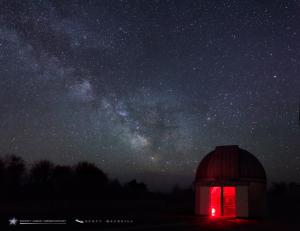
Stargazing Night
- Where:
- Frosty Drew Observatory
- When:
- Friday June 19, 2015 at 6:00 p.m.
- Cost:
- $1 Suggested Donation per Person
Tonight's forecast is quite variable with numerous conflicting forecasts. Our best estimate at this time is for cloudy conditions this afternoon with possible clearings after sunset. Though fog, as usual, will be a factor and can move in quite early. This is rather unfortunate that almost every Friday night since switching to summer mode has had a similar forecast. The 11% waxing crescent Moon will be hanging beautifully in twilight just over the western horizon until it sets at 10:26 p.m. Tonight's forecast is not too inspiring at this point, though skies could turn out OK.
We plan to open the Observatory and Sky Theatre at 6:00 p.m. with live views of the solar photosphere showcasing the massive sunspot 2371 which has moved into view on the Western side of the Sun this past week. The Nature Center will open from 7:00 – 10:00 p.m. with naturalists on hand to answer questions and showcase the daytime side of Frosty Drew. Once the sun sets, we will switch over to the night sky. Venus, Jupiter, and the Moon will all be hanging out in the western twilight sky offering views. We'll start with the super thin crescent Moon followed by Venus, which has moved into a beautiful 42% crescent phase, then Jupiter, with all four Galilean Moons visible until Io passes in front of Jupiter and out of our view. Saturn will be our showcase target of the night with its fabulous rings and up-to five visible moon. Depending on fog and cloud cover, we could have fabulous views of the super dark skies after 11:00 p.m. with the Milky Way becoming strikingly visible over the Observatory. The Sky Theatre will be open with live views, slide shows and commentaries.
Overall, tonight's skies are hard to predict. We could have OK viewing and we could be clouded out. If you are making the long drive, you may want to sit this one out as forecast conditions are deteriorating as the day progresses. Following us on Twitter (@FrostyDrewOBSY) or Facebook will get you periodic updates from the Observatory to help you make an informed decision. Though skies are still variable, our astronomers will be on site and ready to rock.
-------------------------------------------------------------------------
Weekly Happenings
Scott MacNeill
On Sunday, June 21st at 12:39 p.m. EDT the Summer Solstice will occur, marking the start of the summer season in the northern hemisphere. At that time Earth's northern hemisphere will be at a maximum tilt of 23.4° towards the Sun. This will place the Sun directly overhead (zenith) on the Tropic of Cancer. Visibly, the Sun will cross the sky at 23.4° above the celestial equator in the northern hemisphere sky and 23.4° below in the southern hemisphere. Additionally, location north of the Arctic Circle will experience 24 hours of sunlight and locations south of the Antarctic Circle will experience 24 hours of night with a brief period of twilight. If that's not enough to get you geared up for summer, the Solstice also brings beach days, late sunsets, no school, up close views of Pluto (see below), and summer fun to all us northern hemisphere residence. Happy Summer Solstice!
Are you ready to catch a view of the surface of Pluto? How about a better understanding of Pluto's magnetic field? Well this is happening in the next few weeks. If you haven't been following the hype of the mind-blowing NASA New Horizons mission, now is the time to get on board and gear up for history making awesomeness when the first spacecraft to visit Pluto swings past the dwarf planet on July 14th!
Launching on January 19, 2006 the NASA New Horizons mission set out on its journey across the Solar System with Pluto in its sites. February 2007 saw New Horizons slingshot Jupiter while catching some stunning views of the gas giant. July 14, 2015 will bring New Horizons within 8,000 miles of the icy dwarf planet. For perspective, Earth's Moon is about 230,000 miles distant on average. Though New Horizons will not acquire orbit around Pluto, it will perform a flyby while firing all science instruments. Data collection will be along the lines of atmospheric readings, magnetic field measurements, and stunning imagery of the dwarf planet's surface. After which, New Horizons will move further into the Kuiper Belt (a region of large asteroid-like objects that Pluto is part of) and study two other Kuiper Belt Objects (KBO).
Dive into the adventure at the New Horizons mission page and gear up for what is certainly the most ambitious solar system mission of 2015.
-Scott


